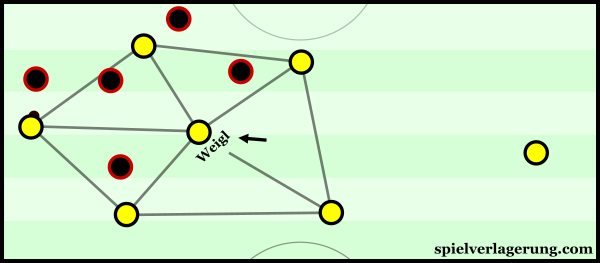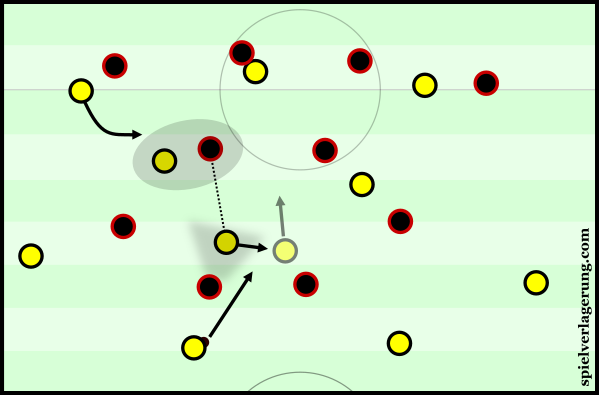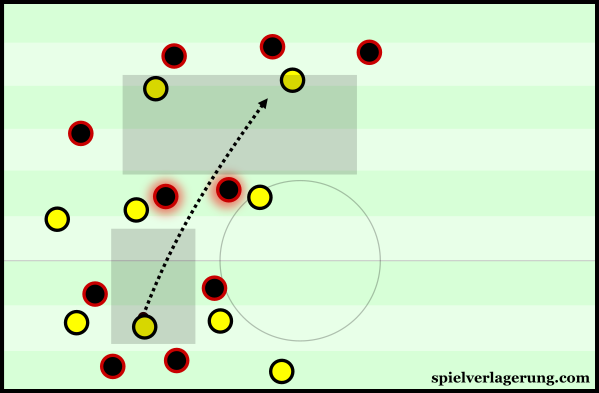Dortmund spacing exploits Leverkusen pressing
In the midst of the busy season, there are several good matches that initially pass under the radar due to the sheer number of fixtures. In this series, our authors analyse some of their favourite games from the 2015/2016 season.
Two of the most progressive young coaches in football clashed as Dortmund took on Bayer Leverkusen on the 5th matchday of the Bundesliga season. After a torrid 14/15 campaign, Dortmund looked a new side and was four from four since they kicked off Tuchel’s reign with a 4-0 demolition of Borussia Mönchengladbach. On the other hand, Schmidt’s Leverkusen had made a less convincing start to the new season and were two from four coming into the match.
Breaking the Leverkusen Press
Roger Schmidt’s side are amongst the best-pressing teams in the world. Not only do they close their opponents down with such great intensity but the coordination of their movements are at a high level too, making them a great threat out of possession. Against such a distinct opponent, it was obvious that the key to the match would be overcoming the Bayer press. Whilst such a task would’ve caused much difficulty for the Dortmund of the season before, Tuchel’s new-look side were far stronger on a structural level and they were more than up to the challenge of their rivals.
During build-up, Weigl maintained his position on the 2nd line and rarely dropped between the centre-backs. From this area, the young ex-1860 player could find gaps behind the opponent’s first line of pressure and try to help his team break through into the centre. This was achieved on a number of occasions as Dortmund were able to break the line of Kießling and Chicharito via the cleverly-positioned Weigl in behind. If it wasn’t Weigl who was receiving the line-breaking pass, his presence in the midfield made for an extra player which in turn gave his teammates a greater chance of finding a gap of uncovered space.
https://twitter.com/TomPayneftbl/status/756173772449783808
The defensive midfielder made a significant contribution to his team’s positional structure from this space just ahead of the centre-backs. As opposed to a position as a third-defender, Weigl could create more triangles in key areas, such as through the half-spaces with the ball-near centre-back and full-back. Additionally he formed triangles which helped connect both Gündogan and Kagawa into the build-up – something which would’ve been much more difficult from a deeper position.

Weigl was key in the connecting the structure to support against the B04 pressure. Without his presence in this scene, Schmelzer would’ve been isolated.
In addition to the calming presence of Weigl, Kagawa supported to stabilise the build-up even more by dropping to a greater extent through the left half-space. Out of the midfield three, the Japanese was usually the highest positioned throughout the first half of the season and acted as a bigger presence in and around the 10 space. However considering the threat which the opponent posed in their pressing game, it made sense for Kagawa to play deeper during build-up, where he supported the shape with more connections and presence against the pressure.
With Kagawa alongside Weigl and Gündogan, a situational three-chain was created on Dortmund’s second line of players, with all three midfielders spaced between the half-spaces. This meant that the centre-backs had a good number of options to play the ball forwards and in turn, Bayer struggled to cover all three at the same time.
Through focusing the play down the left side of the pitch, Dortmund were able to use the playmaking ability of Hummels more often in possession. As one of the best-passing centre-backs in the world, the German defender was capable of breaking the opposition lines of defence with a single pass to break the press from deep positions. Not only could this negate Leverkusen’s pressing, but on a number of occasions it allowed them to exploit the midfield space behind.
Aside from their play in possession, Dortmund’s structure supported their efforts during the transitional moments of the game too. With Bayer putting so much focus on both attacking and defensive transition, Tuchel’s side had to ensure that the defence was stable upon losing possession and this was achieved through their counterpressing. By closing the opposition down as soon as soon as the ball is lost, a team can restrict their ability to play the ball directly forward and instigate a counter-attack.
Dortmund formed an effective counterpress against Bayer Leverkusen and this was in large way a result of their strong positional structure with the ball. The strong levels of connections throughout the shape translated into a high level of defensive support during pressing whilst the close-distance to the ball meant that the pressure could be made almost instantly. As a result, Leverkusen struggled to generate many significant chances on the breaks beginning from deep positions.
Leverkusen’s Identity Crisis
We saw a somewhat uncharacteristic performance from Leverkusen on defence, as they struggled to stay compact in the centre whilst closing down the opposition build-up. Their shape was fairly standard with Kießling and Chicharito leading the line with Bellarabi and Çalhanoglu on the 2nd line. This 4-2-2-2 shape often shifted towards a 4-2-4 block during Dortmund’s build-up with the wingers taking up aggressive positions close to the two strikers.
The front line would put pressure on Dortmund’s two centre-backs and would take every opportunity to move upfield on the cue of a trigger such as a slow, horizontal pass. Acting in their respective half-spaces, both Çalhanoglu and Bellarabi were in advanced positions as they looked to support the efforts of Kießling and Chicharito. In this position, Leverkusen seemingly had the intention of blocking any Dortmund passes into the midfield and instead forcing Dortmund to go long. This left Kampl and Kramer in charge of covering the central areas of the midfield and they were fairly man-oriented towards Kagawa and Gündogan in doing so. Due to the high positioning of the front four however, the central midfield were left with too-large an amount of space to cover and Bayer lost copmactness in doing so.
Their opponents had a rather intelligent reaction to his structure as they overloaded the centre to expose Kampl and Kramer. During build-up, Weigl would cleverly position himself between the B04 strikers and central midfielders but stay close to the front line in the blind spots of Chicharito and Kießling. From this position he would try to stay within the passing lane between the two strikers in order to receive the ball from Hummels or Sokratis. By staying closer to the Bayer strikers, it meant that Weigl was often out of reach for the central midfield pairing – if they moved up to cover the defensive midfielder then their defensive spacing would be weakened and space would be open in deeper positions.
Leverkusen didn’t just struggle with the coverage of Weigl however, as they were often unable to to cover the space both in-front and behind of the double-8. Whilst the Dortmund six was enjoying space in front of the Bayer midfield, the likes of Kagawa and Mkhitaryan were being more influential in gaps behind them. To make matters worse for Schmidt’s side, Aubameyang was free to also drop into the midfield when the situation deemed necessary, adding another body to the overloads. Taking up such a high position on the pitch, space was to be found in the midfield once Bayer’s press had been beaten, and a breakthrough such as a Hummels vertical pass was the perfect opportunity to attack at speed behind the opposition midfield.
Upon Dortmund breaking through the midfield lines, it was surprising to see a distinct lack of intensity in the backwards-pressing and recovery movements of the now-bypassed midfielders. Both Bellarabi and Çalhanoglu were often lethargic in their attempts to regain a strong defensive position and it allowed Dortmund even more time to take advantage of their open space. It meant that Kampl and Kramer had an even more difficult task of covering the opposition attackers whilst in some cases they had to commit themselves to stop Dortmund. The same problem was prevalent in transition too, which gave Mkhitaryan and company the opportunity to create some threatening fast breaks.
Even when more compact within their own third, Leverkusen were caused problems by the Dortmund needle-players. The likes of Mkhitaryan, Kagawa and Gündogan possess excellent technique which allows them to maintain possession in tight areas and this showed as Dortmund were able to form attacks against Bayer’s deeper block. A prime example of this being the second goal, as Kagawa and Mkhitaryan combined on the edge of the box to give the Japanese 10 a clear shot on goal. This was particularly evident through the left half-space where the team once again focused their attacking efforts. If they weren’t switching the ball towards the right, they were looking to combine through Mkhitaryan, Kagawa and Schmelzer to break through the left.
Exploiting the Right Flank
A key principle to Dortmund’s attacks in the first half of the season was their switches of play. With the possession oriented largely around the left half-space, players such as Kagawa, Hummels, Weigl and Schmelzer all convened in and around this area of the pitch. As Reus was restricted to the bench, it was Henrikh Mkhitaryan who took on the left side of the attack. The now-Manchester United player is one of the best in the world when it comes to his team-tactical intelligence and this, as well as his excellent technique in tight spaces made Dortmund’s possession through the left highly dynamic and pressing resistant.
Through this pressing resistance generated down the left, Bayer Leverkusen found it more difficult to effectively close down the spaces around the ball. The intelligent positional game of Dortmund helped Tuchel’s side in their attempts to maximise the space available for players such as Kagawa and Mkhitaryan. With an increased amount of space, they were able to negate the Leverkusen defensive efforts and give themselves time to pick out penetrative passes. A common play upon breaking the opponent’s access was to shift the ball to the right side of the pitch, where Ginter and Hofmann were waiting in anticipation.
https://twitter.com/TomPayneftbl/status/755749611999027200
Switches of play are one of the most effective tools against Bayer Leverkusen as it is a means of exploiting their defensive setup. In order to reach the level of pressure which Schmidt’s side try to enforce, the defensive shape has to be in close vicinity of the ball to allow more players to close the opposition down. However because of this, the opposite side is often uncovered meaning that if the opposition are able to switch possession, then they can create a very threatening situation. Bayer’s pressure often means that teams struggle to switch the ball due to the threat of losing it in the process, but Dortmund were able to negate the pressing through their technically-capable players and spatial focus.
If they weren’t looking to create isolations down the right, Dortmund alternatively would look to break through the same left half-space which they built play in. Hummels could once again take on his more aggressive positioning and offer the same line-breaking passes which put Gladbach to the sword a few weeks prior. Dortmund’s deep playmakers were effective in taking advantage of Leverkusen’s poorly-coordinated press and it allowed the forwards to receive possession in behind the pairing of Kampl and Kramer The collective pressing resistance of Schmelzer, Mkhitaryan and Kagawa worked well in breaking down the opposition defence through dynamic combinations and intelligent movements off of the ball.
Developments
After taking the lead, the balance of the game became more even yet Dortmund were still in control for the large majority. Bayer were only able to generate two clear chances which came in transition and otherwise, both Hummels and Sokratis put in excellent defensive performances as they intercepted many attacking passes.
Whilst they were able to see more of the ball, Dortmund’s impressive pressing stopped many serious attacks from developing, the movements of the front four were coordinated smoothly with sufficient levels of compactness. When holding possession within Dortmund’s third, Tuchel’s side offered little space in the centre and Bayer struggled to find alternative methods of breaking through. They were unable to create any meaningful chances during sustained possession with the only two major threats coming in attacking transition.
In complete contrast to the hosts’ performance, Bayer’s uncompact and dysfunctional pressing game allowed Dortmund to continuously threaten in possession of the ball. They were consistently able to find open space in the midfield after breaking through the first and second lines of Bayer defenders. Although the intensity of Leverkusen’s pressing movements increased, especially after the 2-0, they were still rather uncoordinated and Dortmund were able to profit as a result.
Conclusion
It was an uncharacteristic performance from Bayer whose press was uncompact and largely ineffective. Yet another weak performance in what was a poor start to the season, Schmidt was asked about the topic in the post-match conference to which he replied – “Our trademark to outnumber near the ball isn’t as noticeable at the moment. We have to find our style again. We aren’t tactically stable yet.”.
On the other hand, Dortmund produced yet another dominant performance against a top Bundesliga side as they continued to prove their return after the previous season’s disappointment. They controlled the match well with an intelligent attacking strategy which saw them comfortably exploit the open nature of the opponent’s defence.




1 Kommentar Alle anzeigen
LdB July 28, 2016 um 4:55 am
Awesome series! Keep up thr good work 🙂
Also amazing to look back and see how Weigl performed constantly well right from the start of the season. You could think a new, young player needs some time to adjust and to develop but he just needed the trainimg camp and there he was.